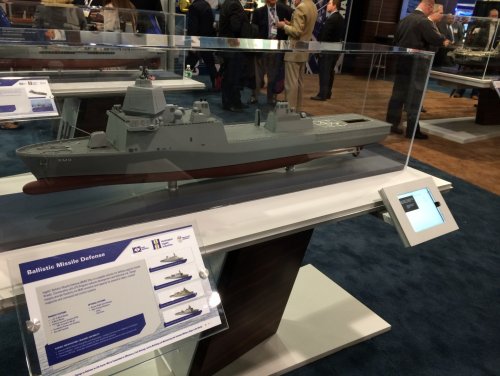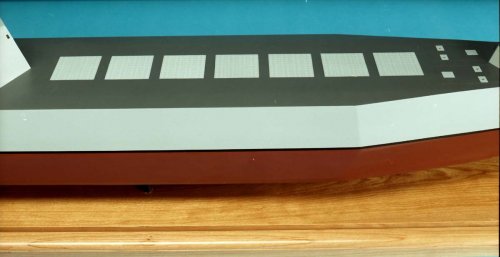From aviation week:
Strictly speaking not an arsenal ship but I found the link at the arsenal ship entry in wikipedia.....and it can be used as such
Introducing the Ballistic Missile Defense Ship
Among the many striking displays at the recent Navy League Sea-Air-Space Exposition was this marvel -- an amphibious warfare ship adapted for Ballistic Missile Defense (BMD), with three times the radar size and missile capacity of current BMD vessels, as well an electromagnetic rail gun that can launch shells to the edge of space.
The concept from Huntington Ingalls Industries’ (HII) is based on the hull of the LPD-17 San Antonio Class, a component of the three-ship “Amphibious Ready Groups” that stage Marines at forward, sea-based positions. In this incarnation, HII has removed the Marine’s berthing, vehicles, helicopters and landing craft, and installed air defense equipment with greater range and capacity than any ship in the fleet.
Atop the superstructure is a massive S-band phased array radar, over 21 feet on each side. Compare that to the 12.5 ft. diameter of the SPY-1 radars aboard Ticonderoga Class Cruisers and Arleigh Burke Class Destroyers. For radars, larger size means greater range and better resolution and these arrays have three times the area of those which equip current BMD vessels.
Starting behind the superstructure and continuing along the periphery to the stern is a vertical launch system (VLS) with 288 cells to carry surface to air missiles (SAMs), Tomahawk cruise missiles or Vertical-launch Anti-submarine rockets (VLAs). For comparison, Ticos have 122; later Burkes 96 and earlier Burkes 90. So, that’s triple the average missile load to start, with plenty of room to install more. Plus, the ship is taller than the surface combatants, which means it can hold future missiles of greater length and range.
Forward of the superstructure, you see what looks like a standard five inch gun, the kind one finds on the Ticos and Burkes. But an engineer responsible for this design explains that’s not what it represents. In fact, it’s an electromagnetic rail gun.
At least two other companies at the Expo exhibited their work on rail guns. The contractors speak of equipping surface combatants with 30+ mega joule (MJ) systems sometime in the 2020s. Elevated for maximum range, those barrels can throw shells a hundred miles away. Elevated higher, they can shoot projectiles to the edge of the atmosphere and possibly beyond.
That capability has caught the attention of missile defense thinkers because the shells might be able to intercept incoming warheads from ballistic missiles. With muzzle velocities of Mach 7, shells accelerated by 30MJ weapons would retain enough speed to engage re-entry vehicles as they fall back into the atmosphere, and possibly enough to chase maneuvering re-entry vehicles (MaRVs) trying to dodge them.
They’re also relatively cheap. Part of the difficulty of missile defense is economic. BMD interceptors like SM-3 often cost several times more than the missiles against which they defend. Using rail guns for BMD could flip that ratio, allowing multiple rounds to be economically expended on a single target. Even if a MaRV has greater kinetic energy than each round – which would confer a maneuvering advantage – it would face difficulty avoiding multiple interceptors while maintaining a course that ends at its target. This is particularly true if when the rounds approach they explode into clouds of hypersonic shards, which is what Boeing has in mind:
Yet another reason rail guns may interest the BMD community is the emerging threat posed by hypersonic glide vehicles (HGVs), such as the one China tested in January. Rather than entering space like normal ballistic missiles, HGVs achieve great speed from their boosters but separate earlier, staying low enough to glide on the air remaining in the stratosphere. Accepting some drag for greater lift, these warheads fly farther than if on a higher trajectory. The benefit is more range and a flight path too low to be intercepted by exo-atmospheric kill vehicles – such as the ones which equip the SM-3 and other mid-course BMD interceptors. The downside is when the warhead nears its target, it has less speed and altitude and is therefore more easily intercepted by low-tier interceptors, including potential rail guns.
While offering greater BMD capability than any other ship operating or planned, the LPD BMD could still provide versatility. The missile cells can launch Tomahawks at land targets. While not currently intended for anti-submarine warfare, acoustic equipment could be added, VLAs can be carried, and the ship can embark helicopters. They could also retain some of their Marine equipment to continue providing amphibious warfare capability.
HII generated this concept about a year ago, and they’re not the only one’s thinking about it. Noted naval analyst Norman Polmar has also spoken of integrating air defense equipment onto amphibious warfare vessels. The two qualities one needs to improve BMD capability are larger radars and more missile cells; features which call for a bigger ship, like an amphib.
The number of missile cells also harkens back to the Arsenal Ship, a notion which floated around the pages of defense publications in the 1990’s. The idea was to design a stealthy, low-visual signature ship which would just barely extend above the water and hold 500 cells for tomahawks, providing unmatched firepower wherever it travelled. The idea came to partial fruition with the conversion of four Ohio class submarines to SSGNs. In place of 24 Trident nuclear ballistic missiles, these subs now carry 154 conventional Tomahawks and comprise 60% of the Navy’s cruise missile strike force. However, they are set to begin retiring towards the end of the decade. The current solution is to add more Tomahawk launchers to the next version of Virginia Class attack subs. It seems LPD BMD could help here as well, as it is conceptually a cross between an amphib, a Burke and the arsenal ship.
But the big difference in feasibility between the SSGNs and the LPD BMD is cost. The four subs had already been bought, except for the Tomahawk equipment. To field LPD BMD vessels, the US would have to pay for new ships, as well as new radars.
How much would it have to pay? So much nobody has asked for a specific estimate. One can make an educated guess though. The last LPD 17 the US bought cost around $2.1B. The most expensive addition to the basic design would be the radar and associated combat system. Aegis combat systems and their SPY-1 radars cost approximately $222M apiece for FY15. However, an engineer responsible for the LPD BMD design states a better analogy would be the “Cobra Judy,” a shipboard radar the US uses to conduct surveillance on foreign ballistic missile launches. Cobra Judy and its carrying vessel costed ~$1.7B for research and construction of one system. Building multiple ships might reduce the cost, but there would also be research and development to conduct on the new radar, which could increase the total cost of each ship significantly. Throw in the other combat systems and $4B seems like a reasonable ball-park, which would make LPD BMD the third most expensive ship class on record, after the Ford Class Carrier and Ohio Ballistic Missile Submarine Replacement.
At that cost, it’s hard to imagine the US ever buying more than a few, but that may be all the military needs. While no ship can be in two places at once, there are only a couple of theaters that require such great BMD defenses. Like the SSGNs, a handful of LPD BMDs could vastly increase capability in the couple of regions where the threat is greatest. Each LPD BMD accommodates up to 288 interceptors and has the space to carry more. China’s entire ballistic missile force numbers approximately 1100.
Unfortunately, there’s not enough money in the budget right now even for a handful. Too bad. It’s a fascinating concept, but in today’s fiscal environment, that’s probably all it’ll ever be … that, and the world’s coolest key chain:
























![TangrediAS-34V[1].jpg](/data/attachments/109/109814-b76d349816f665e4b0a54f297618a491.jpg)